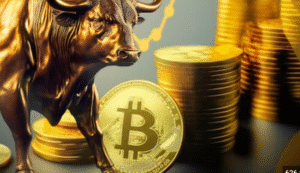$BTC $TSLA $CRYPTO
#Bitcoin #BTC #ElonMusk #JimCramer #Cryptocurrency #CryptoMarket #CryptoNews #FinancialAnalysis #MarketTrends #CryptoInvesting #Blockchain #DigitalAssets
Tech magnate Elon Musk took to social media to express his amusement at a notable dip in Bitcoin’s price following a bullish endorsement by renowned financial analyst Jim Cramer. The cryptocurrency, often recognized as the face of decentralized finance, experienced a sudden decline in value just after Cramer championed its outlook. Market participants were quick to speculate on whether this reaction was merely coincidental or reflective of a broader skepticism tied to Cramer’s market calls, often humorously categorized as an indicator for contrarian strategies. Musk’s reaction, which drew both laughter and intrigue, only added another layer of complexity to this peculiar market behavior.
Bitcoin’s decline following a high-profile endorsement shines a spotlight on the volatility that defines the cryptocurrency market. As Cramer’s endorsement hit the airwaves, Bitcoin initially showed considerable stability, hinting at investor optimism. However, the downturn that followed revealed a fragile sentiment lurking beneath the surface, suggesting broader macroeconomic factors or selling pressure might have been at play. With Bitcoin trading in a sensitive zone, hovering either side of the $35,000 mark, even minor shifts in perception or institutional involvement create outsized impacts on its pricing. Analysts argue that Musk’s public note of amusement underscores the unpredictable nature of cryptocurrency trading, where social and psychological influences are as pertinent as supply and demand.
The broader implications of this event extend beyond just Bitcoin. The crypto landscape itself has long been perceived as susceptible to hyped opinions and influential voices – a defining characteristic but one which raises questions about the sector’s maturity. Musk’s own frequent interactions regarding cryptocurrencies bring attention to how influential individuals can inadvertently sway short-term movements in digital assets. Likewise, the juxtaposition of Cramer’s traditional market perspective against crypto’s ethos of decentralization serves as a fascinating case study on the intersection between traditional and digital financial ecosystems. Market participants are now questioning whether mainstream endorsements help legitimize these assets or further inflate their speculative nature.
In terms of market sentiment, Bitcoin’s pullback post-endorsement could indicate a correction from overbought conditions, as many investors await clarity regarding macroeconomic policy, particularly interest rates and inflation data. However, skeptics suggest this could also signal fatigue or barriers to adoption stemming from regulatory scrutiny and liquidity issues in global markets. For investors, this episode reiterates the complexity of navigating cryptocurrency markets, where whimsical tweets and media proclamations can overshadow fundamentals. Musk’s light-hearted remark, though fleeting, highlights the highly reactive environment surrounding Bitcoin and cryptocurrencies as a whole – a domain still struggling to solidify its standing within the broader world of finance.











Comments are closed.